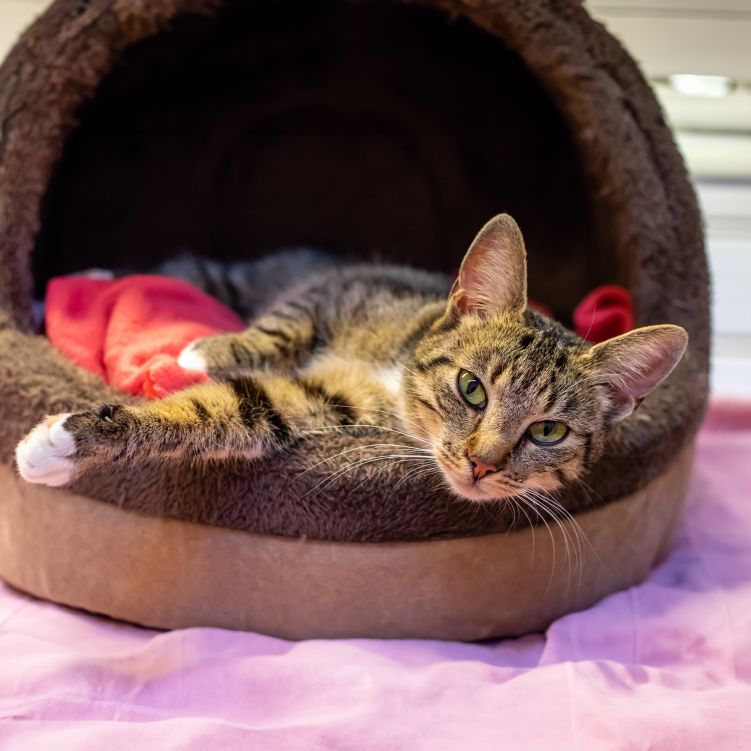The importance of a safe and stimulating environment for cats
Meeting your cat’s environmental needs is essential to ensure their physical and mental well-being. Cats thrive when they have choices about where they eat, drink, rest, play, scratch, and toilet, as well as opportunities to engage in natural behaviours such as stalking, pouncing, climbing, scratching, hiding, retreating, and exploring. By providing an optimal environment, you can minimise negative experiences, promote positive ones, and help your cat lead a happy and healthy life. Addressing these core needs can help reduce unwanted behaviour, and encourage safe, appropriate, and social behaviours.
Read on to explore the five pillars of a healthy feline environment and how to create a cat-friendly space.
Providing a safe place
Cats need private, safe, and quiet places to retreat when they feel threatened or overwhelmed. Each cat perceives threats differently, and their sensitivity to potential dangers can vary. These safe spaces allow cats to feel secure, protected, and in control of their environment.
A retreat doesn’t have to be elaborate—it could be as simple as an elevated shelf or a soft bed tucked away in a quiet corner. Remember, the perceived threat doesn’t need to be immediate or real for your cat to want to seek refuge. By offering your cat the choice to withdraw when needed, you’re supporting their emotional well-being and helping them manage stress effectively.
Multiple and separated key environmental resources
The essential resources that cats need include feeding and drinking stations, toileting areas, places to scratch, opportunities to play, and areas to sleep, rest, and hide. Cats have an innate need to protect resources which are essential for their survival and so being able to access these in places that are safe and protected and away from perceived threats (such as other cats, other animals, busy areas, and people) is important.
To reduce stress and potential conflict, ensure these resources are:
- Multiple: Provide more than one option for each resource, especially in multi-cat households.
- Separated: Place resources in different locations to provide choice, help reduce stress and decrease competition and conflict over resources.
Play and predatory behaviour
Playtime is more than just fun for your cat—it’s essential for their wellbeing. You can simulate important predatory behaviours through play with interactive toys and food-based activities.
Providing opportunities for predatory play helps to keep your cat mentally and physically stimulated, promoting good welfare and reducing boredom and frustration. It also helps prevent health issues like obesity by encouraging physical activity.
Positive, consistent, and predictable human-cat social interaction
Your cat will benefit greatly from positive, consistent, and predictable interactions with people. The earlier this starts, the better, as early consistent positive experiences with people reduces fear and stress the cat feels around people during their life.
It’s important that when you interact with your cat, this is on their terms so that they have choice about the interactions and feel like they are in control of the situation, and so feel comfortable and secure.
Provide an environment that respects the cat’s sense of smell and other senses
Cats use all of their senses as an important way to assess their environment. This includes assessing the environment for threats, communicating with other cats (and other animals and humans), searching for food, and more.
Smell, in particular, plays a significant role in how cats communicate, identify threats, and explore their surroundings. Cats mark their territory using scent glands on their face and paws, creating a sense of familiarity and security. Respecting these scent markings and avoiding strong or unfamiliar scents, like perfumes or citrus, can help reduce stress and maintain a sense of stability for your cat.
Their other senses—sight, hearing, touch, and taste—also influence how cats interact with their environment. Consider the following:
- Sight: Minimise exposure to sights that may cause fear or frustration, such as unfamiliar animals.
- Hearing: Avoid loud or unpleasant noises and offer a quiet space for your cat to escape to if needed.
- Touch: Provide varied textures, from soft bedding to scratching posts. Handle your cat gently and respect their preferences for touch.
- Taste: Offer a range of tasty, nutritious foods and use treats to create positive experiences and help train your cat.
Providing a safe and stimulating environment for your cat is an ongoing process that requires attention to their evolving needs. By following these five pillars, you can ensure your feline friend has a space designed with their happiness and health in mind where they can thrive.
For more information visit the Safe and Happy Cats website or check out these guidelines.







